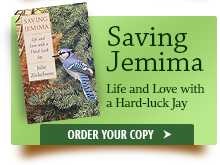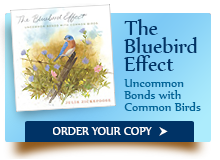It's a painful thing, as you can see from her swollen red eyelids.
About that Goldfinch
Friday, March 28, 2025
On February 27, a sick goldfinch I'd been watching for a week or more finally became blind enough to catch. Her eyes had sealed all but shut. I walked up on her blind side, and caught her in my hand as she sat on the platform feeder. Here's how she looked from above, her eyes so swollen by Mycoplasma infection that her entire head looked weird and big. This is called house finch disease, because house finches are the primary vector. They first caught it in the early 1990's from our domestic chickens, and have little resistance to it. And now house finches have spread it to more than 35 species of wild birds. I like house finches. Nice little birds. I hate house finch disease.
She sat, quiet and still and mute. The first thing to do was mix up some tylosin tartrate (Tylan), an antibiotic effective against Mycoplasma spp. , which I get from my veterinarian. I held her in my hand as I administered that solution, drop by drop. Birds with house finch disease are very thirsty, and spend lots of time sitting on bird baths, which of course allows them to infect lots of other birds. I wanted to get this bird out of the mix at my feeder, so I caught her and put her in a small plastic Critter Keeper with a couple of small crocks of hulled sunflower seed and medicated water. By that evening, her eyes had opened enough so she could see me! It always feels like a miracle that Tylan works that fast. But she had a long way to go. To clear her system of the germ, I'd have to medicate her for three weeks.
But here's the good part. Once she could see, I could move her into a large cage. Then, all I had to do was keep her in fresh Tylan-medicated water and food, and leave her the heck alone. The healing was up to her.
Here she was only a week later. Understand: she wasn't always this agitated. This behavior is elicited by my entering the room and making a video. She was perfectly calm until she saw me! I was the monster who caught her and made her drink medicine.
By March 12, she was looking and acting ever so much better.
She'd had two weeks of treatment when I had to leave to speak at the Michigan Bluebird Festival. I left her in the loving care of my neighbor, Martha J., who is a bird whisperer. When I saw her last, canary babies had just hatched in two nests in her bird room! Martha kept my goldfinch isolated in a back room for almost a week, until I got back with Phoebe in tow. I felt confident leaving the wild bird with Martha, because she'd been medicated for two weeks and was asymptomatic, and Martha was careful about containment. I'm very grateful she could step in. Thank you SO much, Martha!! It's really hard to do wildlife rehab when you travel for work.
Only one day to go until release time! I put her in the basement because Liam came home for a few days to see us, and I couldn't use his bedroom as a finch sanctuary any more. She's sharing space with an enormous geranium called Frank Headley, one of three huge mother plants I have kept over the winter. Ain't it gorgeous? A semi-dwarf zonal geranium developed in the U.K. in 1957. I adore it and plan to propagate it very soon.
Finally, March 20 came. I love this little release video Phoebe made. Goldfinches don't stop to say thanks and goodbye. They just GO.
May this bird be the only sick one I treat this spring. There's an element of luck to it, but more to the point, I'm not using tube feeders--only port-free mesh cylinders and small platform feeders. Everything is covered by hanging acrylic domes that keep droppings from falling into the food.
I'm feeding sunflower hearts, safflower, and peanuts both in and out of shell in a small gray hanging platform feeder (behind the cylindrical peanut feeder), and suet and black oil sunflower hang from the other two hooks.
I just ran outside to shoot these photos. Brrr!! It's 56 and incredibly blustery. Gusts up to 39 mph make it feel like about 40 degrees out there! This is a somewhat better look at the small platform feeder in the foreground. I love this one because the birds tend to perch on the rim to feed, butts over the ground, and don't crap into their food. Good feeder hygiene is all about controlling poop. And I don't use tube feeders because goopy sick bird eyes rub against the ports. So think about that. If you've got disease at your feeders, your first best step is to discontinue using tube feeders. Next, stop feeding when the weather is reliably warm. If you feed all summer long, you'll probably wind up feeding familes of house finches, who will happily breed nearby, producing multiple broods. Yay! you'll have even more disease vectors for your feeding program. See the connection?
I save SO much money on seed now that the squirrels can't make it up the pole! The sliding baffle is very effective, as long as they can't leap from a nearby tree--which they sometimes manage to do.
Thought you'd appreciate some birdfeeding tips from someone who's been at it since she was about 10. Hard-won experience has led me to the conclusions I state here. Farewell, little goldfinch, and try to stay out of trouble now.
|
Widget for blogger by Way2Blogging | Via Spice Up Your Blog Gadgets
|












0 comments:
Post a Comment